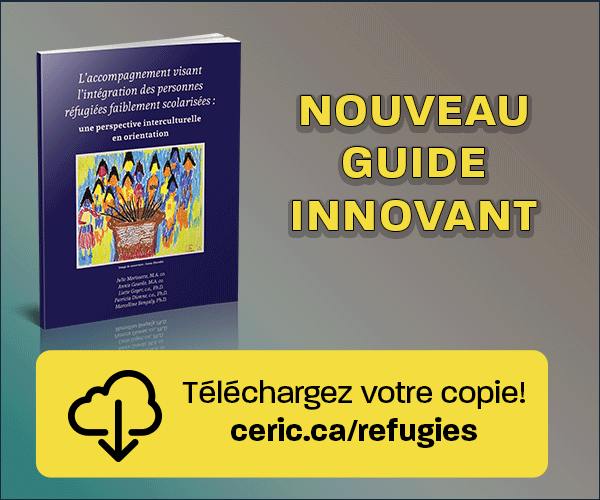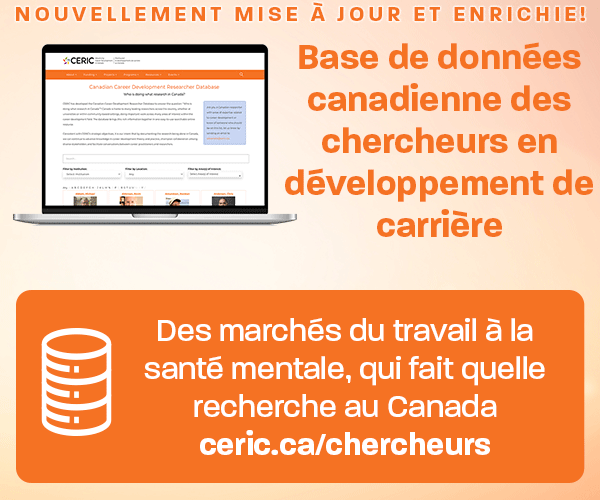Aborder la fatigue de compassion en utilisant l'engagement professionnel et le modèle centré sur l'espoir pour le développement de carrière
DOI :
https://doi.org/10.53379/cjcd.2023.351Mots-clés :
l'épuisement de la compassion, satisfaction de la compassion, engagement professionnel, interventions sur la carrière centrées sur l'espoirRésumé
La pandémie de COVID-19 a fait payer un lourd tribut aux travailleurs de la santé, qui ont dû travailler dans des moments de grand défi et de pénurie, ainsi que de risque pour eux-mêmes, tout en continuant à fournir des soins aux autres. Ce désir de soulager la souffrance d'autrui expose les travailleurs de la santé à un risque accru de fatigue de la compassion, une réponse de stress traumatique qui peut se développer en soutenant les autres dans leur souffrance émotionnelle et en essayant de soulager cette douleur. Le risque accru pour cette vaste population pose un défi aux praticiens de carrière, qui auront besoin de moyens efficaces pour soutenir ces travailleurs dans leur guérison. Cet article traite de la conceptualisation de l'usure de compassion à travers une lentille d'engagement professionnel, et propose l'utilisation du modèle de développement de carrière centré sur l'espoir comme moyen de soutenir le réengagement. Grâce à la réinstallation de l'espoir, le sentiment d'agence et d'accomplissement devient à nouveau possible.
Références
Amundson, N. E. (2010). Metaphor making: Your career, your life, your way. Richmond, B.C.: Ergon Communications.
Amundson, N. E. (2015). Using metaphor in career intervention. Eds. P. Hartung, M. Savickas, W.B. Walsh. APA Handbook of Career Interventions: Volume Two / Applications. Washington, DC: American Psychological Association.
Amundson, N., Niles, S., Yoon, H. J., Smith, B., In, H. & Mills, L. (2013). Hope-centered career development for university/college students. Toronto: Canadian Education & Research Institute for Counselling.
Amundson, N., Goddard, T., Yoon, H. J., & Niles, S. (2018). Hope-centred interventions with unemployed clients. The Canadian Journal of Career Development, 17(2). https://cjcd-rcdc.ceric.ca/index.php/cjcd/article/view/81
Arpacioglu, S., Gurler, M., & Cakiroglu, S. (2020). Secondary traumatization outcomes and associated factors among the health care workers exposed to the COVID-19. International Journal of Social Psychiatry, I-6. https://doi.org/10.1177/0020764020940742
Conrad, D & Kellar-Guenther, Y. (2006) Compassion fatigue, burnout, and compassion satisfaction among Colorado child protection workers. Child Abuse and Neglect. 30(10) 1071-1080. https://doi.org/10.1016/j.chiabu.2006.03.009
Eklund, M., & Erlandsson, L. (2011). Return to Work Outcomes of the Redesigning Daily Occupations (ReDO) Program for Women with Stress-Related Disorders—A Comparative Study. Women & Health, 51(7), 676-692. https://doi.org/10.1080/03630242.2011.618215
Figley, C. R. (2001). Compassion fatigue as secondary traumatic stress: An overview. In C. R. Figley (Ed.), Compassion fatigue: Coping with secondary traumatic stress disorder (2nd ed., pp. 1-20). New York, NY: Bruner/Mazel.
Figley, C. R. (2002). Compassion fatigue: Psychotherapists’ chronic lack of self care. Journal of Clinical Psychology, 58(11), 1433-1441. https://doi.org/10.1002/jclp.10090
Figley, C. R. & Nelson, T. S. (1989). Basic Family Therapy Skills, I: Conceptualization and Initial Findings. Journal of Marital and Family Therapy, 15(4), 3349-365.
Freudenberger, H. J. (1974). Staff Burn-Out. Journal of Social Issues, 30(1), 159–165. https://doi.org/10.1111/j.1540-4560.1974.tb00706.x
Greenberg, N., Docherty, M., Gnanapragasam, S., & Wessely, S. (2020). Managing mental health challenges faced by healthcare workers during covid-19 pandemic. BMJ, 368(m1211). https://doi.org/10.1136/bmj.m1211
Hinton, D., & Lewis-Fernández, R. (2011). The cross-cultural validity of posttraumatic stress disorder: Implications for DSM-5. Depression and Anxiety, 28(9), 783-801. https://doi.org/10.1002/da.20753
Hunt, P., Denieffe, S., & Gooney, M. (2019). Running on empathy: Relationship of empathy to compassion satisfaction and compassion fatigue in cancer healthcare professionals. European Journal of Cancer Care, 28(e13124). https://doi.org/10.1111/ecc.13124
Killian, K. D. (2008). Helping till it hurts? A multimethod study of compassion fatigue, burnout, and self-care in clinicians working with trauma survivors. Traumatology, 14(2), 32-44. https://psycnet.apa.org/doi/10.1177/1534765608319083
Korte, J. J., Bohlmeijer, E. T., Cappeliez, P. P., Smit, F. F., & Westerhof, G. J. (2012). Life review therapy for older adults with moderate depressive symptomatology: A pragmatic randomized controlled trial. Psychological Medicine, 42(6), 1163-1173. https://doi.org/10.1017/s0033291711002042
Kreitzer, L., Brintnell, S. E., & Austin, W. (2020). Institutional barriers to healthy workplace environments: From the voices of social workers experiencing compassion fatigue. British Journal of Social Work, 50, 1942-1960. https://doi.org/10.1093/bjsw/bcz147
Ling, J., Hunter, S. V., & Maple, M. (2014). Navigating the Challenges of Trauma Counselling: How Counsellors Thrive and Sustain Their Engagement. Australian Social Work, 67(2), 297-310. https://doi.org/10.1080/0312407X.2013.837188
Maslach, C. (1976). Burned-out. Human Behavior, 9(5), 16–22.http://www.ncbi.nlm.nih.gov/pubmed/260904
Maslach, C., Schaufeli, W. B., & Leiter, M. P. (2001). Job burnout. Annual Review of Psychology, 52, 397-422. https://www.annualreviews.org/doi/abs/10.1146/annurev.psych.52.1.397
Neault, R. A., & Pickerell, D. A. (2011). Career engagement: Bridging career counseling and employee engagement. Journal of Employment Counseling, 48(4), 185-188. https://doi.org/10.1002/j.2161-1920.2011.tb01111.x
Newman, K. L. (2011). Sustainable careers: Lifecycle engagement in work. Organizational Dynamics, 40(2), 136-143. https://doi.org/10.1016/j.jvb.2018.06.011
Niles, S., Amundson, N. & Neault, R. (2011). Career flow: A Hope-centered approach to career development. Columbus, OH: Pearson, Merrill Prentice Hall.
Niles, S. G., In, H. & Amundson, N. (2014). Using an action oriented hope-centered model of career development. Journal of Asia Pacific Counseling, 4, 1-13. https://doi.org/10.18401/2014.4.1.1
Niles, S. G., Yoon, H. J., Balin, E., Amundson, N. E., (2010). Using a hope-centered model of career development in challenging times. Turkish Psychological Counseling & Guidance Journal, 4(34), 101-108. https://dergipark.org.tr/tr/download/article-file/200146
Ray, S. L., Wong, C., White, D., & Heaslip, K. (2013). Compassion satisfaction, compassion fatigue, work life conditions, and burnout among frontline mental health care professionals. Traumatology, 19(4), 255-267. https://doi.org/10.1177/1534765612471144
Ruiz-Fernandez, M. D., Ramos-Pichardo, J. D., Ibanez-Masero, O., Cabrera-Troya, J., Carmona-Rega, M. I., & Ortega-Galan, A. M. (2020) Compassion fatigue, burnout, compassion satisfaction and perceived stress in healthcare professionals during the COVID-19 health crisis in Spain. Journal of Clinical Nursing, 29, 4321-4330. https://doi.org/10.1111/jocn.15469
Saakvitne, K., Pearlman, L., & Abrahamson, D. (1996). Transforming the pain: A workbook on vicarious traumatization. Retrieved from http://dissertation.argosy.edu/chicago/Summer09/PP8950_SuI09Zakowski.doc
Singh, J., Karanika-Murray, M., Baguley, T., & Hudson, J. (2020). A systematic review of job demands and resources associated with compassion fatigue in mental health professionals. International Journal of Environmental Research and Public Health, 17. https://doi.org/10.3390/ijerph17196987
Smart, D., Enlish, A., James, J., Wilson, M., Daratha, K. B., Childers, B., & Magera, C. (2014). Compassion fatigue and satisfaction: A cross-sectional survey among US healthcare workers. Nursing & Health Sciences, 16(1), 3-10. https://doi.org/10.1111/nhs.12068
Smith, B. A., Mills, L., Amundson, N., Niles, S., Yoon, H. J. & In, H. (2014). What helps and hinders post-secondary students who maintain high levels of hope despite experiencing significant barriers. Canadian Journal of Career Development, 13, 59-74. https://cjcd-rcdc.ceric.ca/index.php/cjcd/article/view/183
Stamm, B. H. (2009). Professional quality of life: Compassion satisfaction and fatigue subscales, R-III (ProQOL). http://www.proqol.org/ProQol_Test.html
Thompson, I. A., Amatea, E. S., & Thompson, E. S. (2014). Personal and contextual predictors of mental health counselors’ compassion fatigue and burnout. Journal off Mental Health Counseling, 36(1), 58-77. https://psycnet.apa.org/doi/10.17744/mehc.36.1.p61m73373m4617r3
Yoon, H. J., In, H., Niles, S. G., Amundson, N. E., Smith, B. A. & Mills, L. (2015). The effects of hope on student engagement, academic performance, and vocational identity. Canadian Journal of Career Development. https://cjcd-rcdc.ceric.ca/index.php/cjcd/article/view/176
Yoon, H. J., Bailey, N., Amundson, N., & Niles, S. (2019). The effect of a career development programme based on the Hope-Action Theory: Hope to work for refugees in British Columbia. British Journal of Guidance & Counselling, 47(1), 6-19. https://doi.org/10.1080/03069885.2018.1544827

Téléchargements
Publié-e
Comment citer
Numéro
Rubrique
Licence
(c) Tous droits réservés La Revue canadienne de développement de carrière 2023

Cette œuvre est sous licence Creative Commons Attribution - Pas d'Utilisation Commerciale - Pas de Modification 4.0 International.











